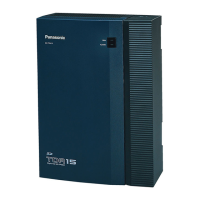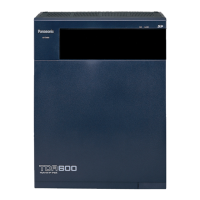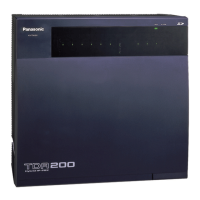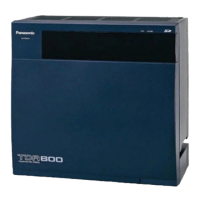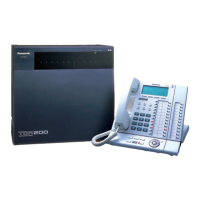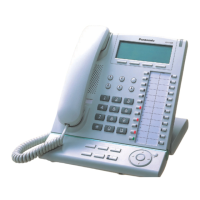TIE Line Programming
To Make a TIE Line Call
The TIE Line Routing and Modification Table is referenced by the PBX to identify the CO line route when an
extension user makes a TIE line call.
It is necessary to make unified tables with all PBXs in the TIE line network.
The routing pattern appropriate for each call is decided by the dialed number.
There are two system programs for the tables:
TIE Line Routing Table: used to assign the leading numbers (PBX code or extension number) and trunk group
hunt sequence.
11.1 [9-1] TIE Table— Leading Number
TIE Modify Removed Number of Digits/Added Number: used to remove digits from and add a number to
the dialed number of the TIE line call. This modification may be needed depending on the TIE line network
configuration.
11.1 [9-1] TIE Table
→ Removed Number of Digits
→ Added Number
→ Trunk Group
[Programming Examples]
Your
PBX is PBX-1 and there are four PBXs in your TIE line network. To identify the CO line route as illustrated,
you should make the following tables.
a. Extension Number Method (Access without PBX Code)
4.8 [2-6-1] Numbering Plan—Main—Other PBX Extension—
Dial
PBX-1
TRG 1
a) 2xxx
PBX-2
PBX-4
TIE Line Network
Extn. 4xxx
Extn. 1xxx
Extn. 2xxx
PBX-3
Extn. 3xxx
c) 4xxx
TRG 2
If you dial:
a) 2xxx
b) 3xxx
c) 4xxx
b-2nd) 3xxx
b-1st) 3xxx
(2, 3, 4: Other PBX
Extension Number
[TIE] in the Flexible
Numbering Plan)
[TIE Line Routing and Modification Table of PBX-1]
Location
No.
Leading
No.
Priority 1 Priority 2 . .
TRG
Dial Modification
TRG
Dial Modification . .
Removed
No. of
Digits
Added
No.
Removed
No. of
Digits
Added
No.
. .
01 2 1 0 . .
Document Version 2010-11 Feature Manual 235
13.1.13 PRIVATE NETWORK FEATURES

